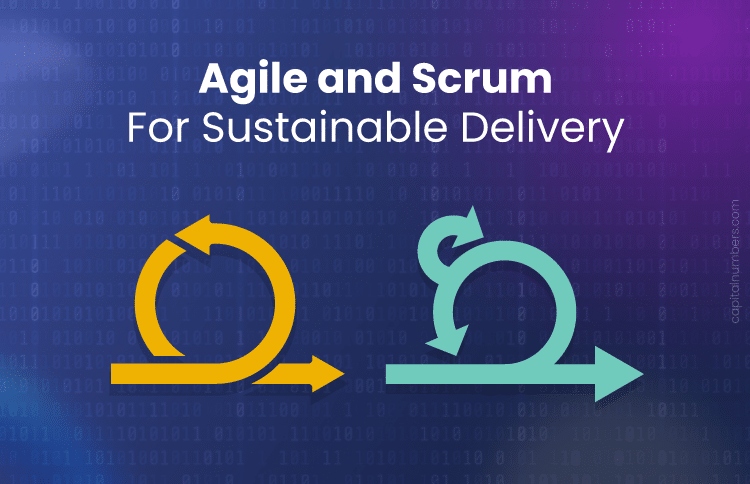Agile and Scrum for Sustainable Delivery
Table of Contents
In the information technology space, businesses are continuously pushed to deliver more user friendly, efficient, and high-quality solutions. To add to the pressure, there are challenging deadlines that often lead to quality issues. Because of the dynamic nature of delivery environments, Agile and Scrum methodologies have been widely adopted by most software development companies. These methods help teams embrace adaptability, enhance collaboration, and boost productivity.
This article aims to thoroughly explore these methodologies. It offers individuals and teams, whether new to Agile and Scrum or seeking a deeper understanding, a guide to these approaches for sustainable success. Agile and Scrum, while often mentioned together, originate from the same philosophical foundations. However, the terms are not exactly interchangeable. They are applied differently within project management. To begin with, let us clarify the foundational aspects of each of the two terms.
Agile Methodology: Emphasizing Iteration, Collaboration, and Continuous Improvement
Agile methodology, a paradigm shift from traditional project management approaches, is intrinsically designed to cope with the complexities and rapid changes frequently encountered in software development and other fields. It is fundamentally structured around the principles of iterative development and continuous delivery. This methodology doesn’t just manage projects—it reshapes how organizations think about delivery, stakeholder engagement, and internal processes.
- Iteration: Flexibility through Incremental Delivery
At the heart of Agile lies the principle of iteration. This concept is critical as it allows teams to break large projects into smaller, more manageable units known as iterations or increments. Each iteration typically spans a short time frame, often ranging from one to four weeks, and aims to produce a working part of the product that adds tangible value to the end users.The iterative cycle is not just about breaking down tasks; it’s designed to encourage adaptability. By delivering parts of the project at regular intervals, teams can manage changes with more flexibility. This adaptability is crucial in today’s fast-paced business environments where requirements can change rapidly due to market shifts, customer feedback, or new technological advancements. Regular iterations enable the incorporation of feedback at nearly every step of development, allowing teams to refine and adjust the output continuously, ensuring that the final product more closely aligns with user needs and expectations.
- Collaboration: Enhancing Outcomes through Stakeholder Engagement
Agile places a significant emphasis on collaboration, underscoring the importance of teamwork, customer involvement, and frequent communication. This collaborative approach ensures that all stakeholders, including project managers, developers, customers, and end-users, are actively engaged throughout the project lifecycle. Constant interaction helps in understanding and integrating diverse perspectives, which is critical in crafting a product that truly meets user requirements.Effective collaboration in the Scrum framework is supported by various practices and tools, such as daily stand-up meetings, sprint reviews, and retrospectives, which facilitate ongoing communication and problem-solving. These practices help prevent silos, ensure everyone is aligned with the project’s goals and progress, and allow for immediate adjustments based on direct feedback or emerging challenges.
- Continuous Improvement: Learning and Adapting to Enhance Efficiency
Continuous improvement is another cornerstone of the Agile methodology. Each iteration is viewed as a learning opportunity, not just for the product development but also for the process itself. Teams regularly evaluate their workflows, techniques, and outcomes to identify what was successful and what could be improved. This reflective practice is typically encapsulated in the sprint retrospective—a dedicated meeting at the end of each sprint where the team discusses what went well, what didn’t, and how processes could be refined.This principle of continuous improvement extends beyond mere project management. It instils a mindset of ongoing personal and professional development within teams. By regularly assessing and optimizing their approach, teams not only enhance their productivity and efficiency but also cultivate a proactive culture that encourages innovation and responsiveness to change.
To sum up, Agile methodology, with its focus on iteration, collaboration, and continuous improvement, offers a robust framework for managing projects in a way that is adaptive, inclusive, and progressively optimized. By embracing these principles, organizations can not only improve the quality and relevance of their products but also enhance their operational agility and responsiveness to the market. Agile isn’t just a set of practices—it’s a strategic choice that aligns development efforts with the dynamic nature of today’s business challenges.
Scrum: Structuring Success Through Sprints, Roles, and Ceremonies
Scrum is a prominent framework within the Agile methodology that introduces a structured approach to managing complex projects. It does this through clearly defined roles, time-boxed activities called sprints, and specific ceremonies that facilitate communication, planning, and reflection. Understanding each component of Scrum is crucial for teams aiming to implement this framework effectively.
- Sprints: The Heartbeat of Scrum
Sprints are fundamental to the Scrum framework. They are short, consistent cycles typically lasting between two to four weeks, during which predetermined sets of project tasks are completed and made ready for review. Each sprint begins with a planning meeting and ends with a review and retrospective, creating a rhythm that drives the pace of development.The primary purpose of a sprint is to break down the project into smaller, manageable chunks that can be completed efficiently and effectively, allowing teams to focus on delivering specific features or components. This method not only facilitates a quicker turnaround in delivering increments of the final product but also helps in managing priorities and reducing the overall project risk by addressing issues in real-time.
- Roles: Defining Responsibilities
Scrum defines three fundamental roles that each contribute uniquely to the project’s success:- Product Owner: This role represents the voice of the stakeholders and the customer. The Product Owner is responsible for defining the project vision, managing the product backlog, and ensuring that the development team delivers value to the business. They prioritize the backlog items based on business value and are the primary decision-maker regarding what features the team works on during each sprint.
- Scrum Master: Often considered a coach for the team, the Scrum Master facilitates Scrum processes, helps resolve impediments, and ensures that the team is fully functional and productive. The Scrum Master works to support the team in achieving their sprint goals and advocates for continuous improvement and adherence to the Scrum practices, making sure that the team is not overburdened or distracted.
- Development Team: The Development Team consists of professionals who do the work of delivering the product increment. This team is cross-functional; meaning it includes all the expertise necessary to complete the project work (like software engineers, designers, and QA specialists). The Development Team is self-organizing, meaning they decide collectively how to best accomplish their work, rather than being directed by others outside the team.
- Events or Ceremonies: Facilitating Communication and Improvement
Scrum’s structured approach is punctuated by several key meetings or ‘ceremonies’ that underpin its iterative process. These include:- Sprint Planning: This ceremony marks the start of the sprint. The team meets to decide what work will be done during the upcoming sprint. The Product Owner presents the prioritized backlog items, and the team selects tasks they can complete during the sprint, turning them into an achievable sprint goal.
- Daily Scrum or Stand-Up: Also known as the daily scrum, this quick meeting is held each day of the sprint, where team members discuss what they worked on the previous day, what they will work on today, and any blockers they are facing. This facilitates a quick exchange of information among team members and helps identify impediments early.
- Sprint Review: At the end of each sprint, the team demonstrates what they have built. This informal meeting allows stakeholders to provide feedback on the increment developed during the sprint, ensuring that the project is aligned with user needs and expectations.
- Sprint Retrospective: Following the review, the team holds a retrospective to reflect on the sprint process. They discuss what went well, what could be improved, and what actions will be taken to improve quality and effectiveness in the next sprint.
To sum up, Scrum’s structured approach to Agile project management—with its clearly defined roles, time-boxed sprints, and facilitating ceremonies—provides a robust framework that fosters clarity, accountability, and efficiency. Teams that embrace these elements can enhance their productivity, adaptability, and ultimately, their success in delivering projects that meet or exceed stakeholder expectations.
Agile vs. Traditional Waterfall Methodology
Understanding Agile and Scrum involves recognizing how they differ from traditional project management methodologies, like the Waterfall model. The Waterfall model is a linear and sequential approach where the project’s scope, requirements, and schedule are determined at the beginning, and any changes can disrupt the entire system. Here’s how Agile contrasts with this approach:
- Flexibility vs. Rigidity: Agile allows for change and adaptation throughout the project life cycle, whereas Waterfall is inflexible once project stages are defined.
- Feedback Loops vs. Final Reviews: Agile encourages regular reviews and adjustments throughout the development process, whereas Waterfall typically has a single review process after a long period.
- Incremental Delivery vs. Single Delivery: Agile delivers work in short increments, allowing stakeholders to review results and adapt before the milestones of long durations are completed.
Benefits of Agile/Scrum
Implementing Agile and Scrum methodologies brings numerous advantages to project management, adaptability, and team productivity:
- Enhanced Project Management: Agile/Scrum improves project predictability and tracking through its iterative process and regular feedback mechanisms. This dynamic approach helps in better managing project risks and changes.
- Increased Adaptability: The flexible nature of Agile/Scrum allows teams to adjust their products based on user feedback and changing market conditions, thereby delivering more relevant and refined products.
- Boosted Team Productivity: By promoting self-organizing teams and maintaining regular sprint cycles, Scrum can enhance focus and productivity. The transparency and continuous improvement ethos also help in maintaining high morale and engagement among team members.
Practical Tips on Implementing Agile/Scrum
Successfully adopting Agile and Scrum depends greatly on the organization’s readiness to embrace change and the specific project types. Here are practical tips for implementation:
- Start Small: If new to Agile or Scrum, begin with a pilot project to understand the nuances before a full-scale implementation.
- Educate and Train: Invest in training for key roles such as Scrum Masters and Product Owners. Continuous learning should be encouraged among all team members.
- Customize to Fit: Adapt the principles of Agile and Scrum to fit the specific needs of the organization and project types. Not every aspect of Scrum will be suitable for every project.
- Use Tools Effectively: Leverage project management tools that support Agile methodologies to plan, track, and execute projects effectively.
- Foster a Collaborative Culture: Encourage open communication and collaboration both within the team and with stakeholders to enhance transparency and trust.
You May Also Read: Adaptive Software Development: The Agile Approach for Modern Projects
Conclusion
Mastering Agile and Scrum is not merely about adopting new processes but transforming mindsets and cultivating an environment that encourages continuous improvement, collaboration, and adaptability. As more organizations recognize the value of these methodologies in driving project success and efficiency, the need for comprehensive understanding and skilled implementation will continue to grow. Embracing Agile and Scrum can lead to sustainable success in today’s competitive and ever-changing business landscape.


















